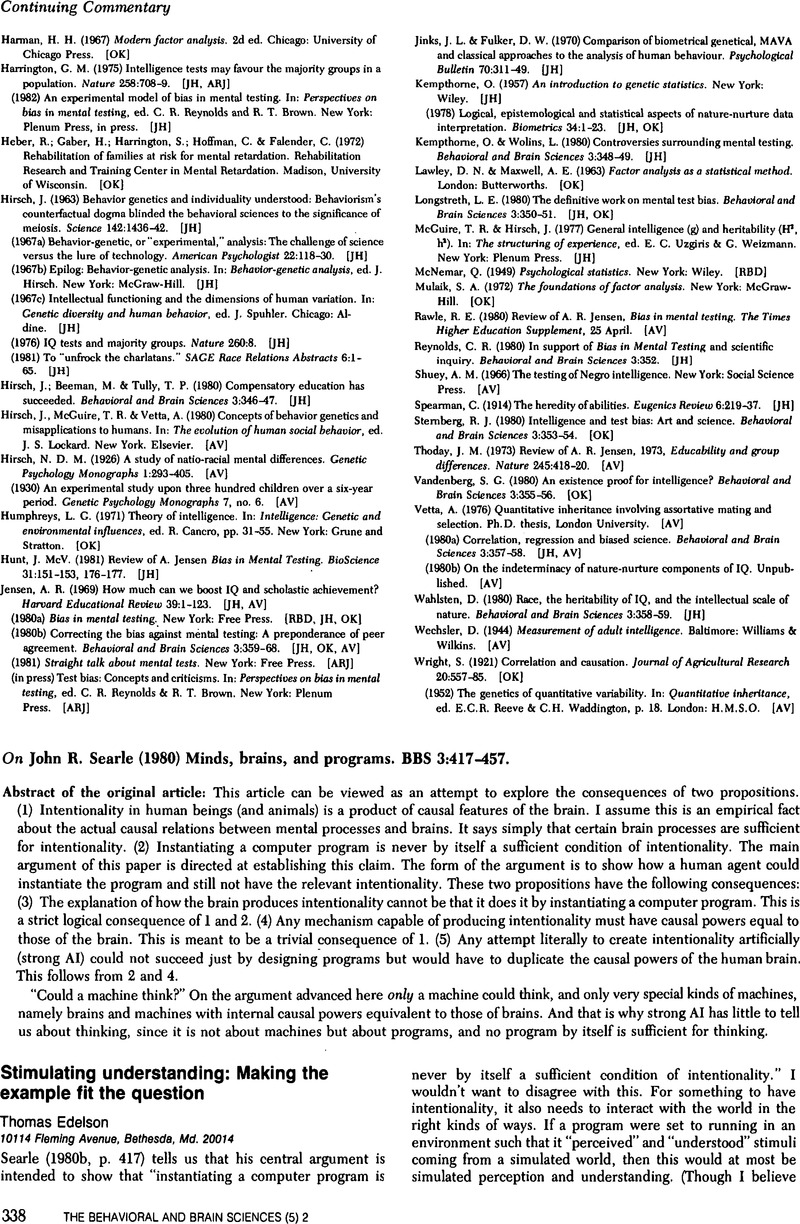Crossref Citations
This article has been cited by the following publications. This list is generated based on data provided by Crossref.
Harvey, R. J.
1985.
On the nature of programs, simulations, and organisms.
Behavioral and Brain Sciences,
Vol. 8,
Issue. 4,
p.
741.
Searle, John R.
1985.
Patterns, symbols, and understanding.
Behavioral and Brain Sciences,
Vol. 8,
Issue. 4,
p.
742.
Maloney, J. Christopher
1987.
The right stuff.
Synthese,
Vol. 70,
Issue. 3,
p.
349.
HARNAD, STEVAN
1989.
Minds, machines and Searle.
Journal of Experimental & Theoretical Artificial Intelligence,
Vol. 1,
Issue. 1,
p.
5.
Searle, John R.
1990.
The causal powers of the brain: The necessity of sufficiency.
Behavioral and Brain Sciences,
Vol. 13,
Issue. 1,
p.
164.
MacQueen, Kenneth G.
1990.
Not a trivial consequence.
Behavioral and Brain Sciences,
Vol. 13,
Issue. 1,
p.
163.
DYER, MICHAEL G.
1990.
Intentionality and computationalism: minds, machines, Searle and Harnad.
Journal of Experimental & Theoretical Artificial Intelligence,
Vol. 2,
Issue. 4,
p.
303.
Weiss, Thomas
1990.
CLOSING THE CHINESE ROOM.
Ratio,
Vol. 3,
Issue. 2,
p.
165.
Harnad, Stevan
1991.
Other bodies, other minds: A machine incarnation of an old philosophical problem.
Minds and Machines,
Vol. 1,
Issue. 1,
p.
43.
Dyer, Michael G.
1994.
Thinking Computers and Virtual Persons.
p.
173.
Marconi, Diego
1996.
On the referential competence of some machines.
Artificial Intelligence Review,
Vol. 10,
Issue. 1-2,
p.
21.
Marconi, Diego
1996.
Integration of Natural Language and Vision Processing.
p.
123.
Cachopo, João
and
Cardoso, Ana
1996.
The Web of Belief: Uma Perspectiva da Inteligência Artificial.
Disputatio,
Vol. 1,
Issue. 1,
p.
25.
Hauser, Larry
1997.
Searle's Chinese Box: Debunking the Chinese Room Argument.
Minds and Machines,
Vol. 7,
Issue. 2,
p.
199.
Teng, Norman Y.
2000.
A cognitive analysis of the Chinese room argument.
Philosophical Psychology,
Vol. 13,
Issue. 3,
p.
313.
Gams, Matjaz
2002.
The Turing Machine May Not Be the Universal Machine.
Minds and Machines,
Vol. 12,
Issue. 1,
p.
137.
Cangelosi, Angelo
and
Parisi, Domenico
2002.
Simulating the Evolution of Language.
p.
3.
Cangelosi, Angelo
Greco, Alberto
and
Harnad, Stevan
2002.
Simulating the Evolution of Language.
p.
191.
Wakefield, Jerome C.
2003.
The Chinese Room Argument Reconsidered: Essentialism, Indeterminacy, and Strong AI.
Minds and Machines,
Vol. 13,
Issue. 2,
p.
285.
Searle, John
2006.
Encyclopedia of Cognitive Science.


